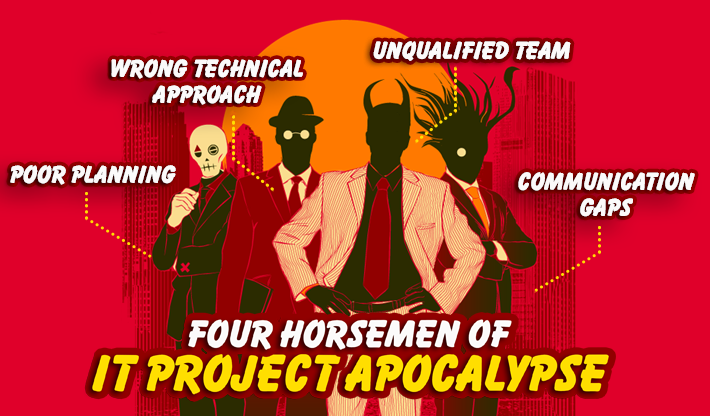IT project failures: 4 horsemen of the apocalypse
Do you know an IT professional with multi-year experience who was never tapped into a failed project? So much has been said and written on IT project management that it seems executives should have less and less trouble with it, but in reality projects continue to fail.
IT project management is a tricky field with apparent and hidden pitfalls at every step. Invisible at the start, sooner or later they cause destructive problems.

Poor planning
Some say the world was created out of the chaos. Can a good IT solution also come out of the chaos? Well, maybe. But is it worth checking when time, money and corporate reputation are at stake? There is a whole bunch of pains that accompany bad planning:
Unclear scope of work
Key players don’t understand what exactly should be done, requirements and goals are described vaguely – what else does one need to cause confusion? No wonder that one day the leadership will realize the project is more complicated than it was expected, and it cannot be delivered on time or within the budget.
Unrealistic time estimates
As soon as the scope of work is blurred, it’s impossible to define how much time the project will take. Also, unrealistic time estimates cause a disbalance between project stages (for example, too little time is given for development or testing).
Sometimes customers (and, why hide the truth, project managers too) have no clear idea about the technical side of the project and thereby ask to do too much in too little time. With strict delivery frames, project participants work overtime and in a hurry and make more mistakes.
Wrong cost evaluation
Planned resources end earlier than the project is completed, and costs get higher than expected.
Mention must be made that some projects are initially underfunded because of excessive focus on cost-saving. The proverb “buy cheap, buy twice” works fine with an immoderate cost-saving policy in IT projects. Cost-effectiveness can be confused with simple greediness.
Bad risk assessment
Even careful planning of project activities can be useless if you don’t analyze in advance what can go wrong with the project, properly assess potential risks and prepare action plans to address them. The risks in IT projects can be connected with time estimates, cost estimates (for example, improper cost distribution and unforeseen cutbacks on funding), project team (a key employee takes a long sick leave or leaves the company, and it takes time to find a new employee suitable for the project and ensure smooth onboarding), chosen technologies (especially if you decide to use innovative techs) and more.
Unforeseen risks can significantly slow down a project because you need to analyze them and plan and implement risk mitigation activities. This way, risks steal much time and money from the planned project activities and even reduce job satisfaction of project participants.
Wrong technical approach
A technical approach includes the choice of software development methodologies, platforms, frameworks, libraries and programming languages. This choice depends, for example, on project goals, size, complexity and costs, as well as on the number of project participants and their skills.
Over the years of activity, a company can become addicted to certain patterns of development and certain types of projects. New challenges throw a company into the unknown and make project managers unsure about the best development options to fulfill project requirements.
If the selected tools don’t align with the project or your team doesn’t know how to use them properly, a project is doomed to failure from the very beginning. Get ready for missing deadlines, uncontrollably growing scope and costs and angry customers.
Unqualified project team
Unskilled or irresponsible project management
Even the best development practices and brilliant programming habits are bootless if IT project managers don’t know how to use them in a project.
Managers are humans: they make mistakes. Novices in IT project management need time and practice to master their skills. Some managers are just not interested in the project and leave it entirely to the technical team. Whatever the reason, the results of weak management are rather depressing:
- Lack of performance and progress control.
- Uneven workload of the team.
- Bad role distribution.
- Ignoring warning signs.
Lack of managerial knowledge and competencies is not always the problem – even a top-class manager with a dozen projects behind can get lost in a new environment.
On the other side, too much management won’t right the ship: the information and instructions are handed down the “management ladder” and may be misunderstood. As the proverb says, too many cooks spoil the broth.
Weak technical team
Project managers are not the only people to blame for IT project failures. A project’s success is a burden shared by all its participants including developers, testers and business analysts. If team members don’t know their jobs, an IT project will certainly fail. Involving more resources won’t save the situation: a project with a few qualified developers supervised by a skilled tech manager has a much greater chance to succeed than one where hordes of tech guys are performing their duties by halves.
To err is human, but if mistakes happen (or even worse – repeat) too often, then something is wrong with the team, and the chances to fail are even higher than expected.
Communication gaps
It’s clear that a project team needs to keep in touch with the customer and conduct internal project-related discussions. However, communication gaps still take place and weight well-planned IT projects down (let alone badly planned ones). The number of the reasons for poor communication makes one dizzy: from technical bugs (slow unresponsive corporate intranet, bad internet connection) to human hang-ups (conflicts, personal problems, a creepy atmosphere in the office). Also, preferred communication channels can be unclear: team members don’t know whether to email, Skype, call or use social networks to reach necessary people. As a result, project participants cannot take joint actions to complete project goals:
- A project team misunderstands the customer’s visions and ideas about the solution due to poor requirement gathering.
- Team members are not sure about their roles, responsibilities and the scope of the project.
- Team members don’t inform each other about the progress and critical issues.
- The vendor does not report updates and troubles to the customer (while it’s better to discuss all issues before they snowball).
- Managers do not inform their teams about requirement updates.
It’s important to keep the balance between too little and too much communication. Too much communication hardly contributes to a project success – it just eats up productive time.
An afterword
The reasons for IT project failures are wide and varied: insufficient planning, underestimated complexity, unqualified project participants, unsuitable tools, banal irresponsibility and more. The earlier you identify and admit that something goes (or can go) wrong, the more chances you have to save time, money and reputation and deliver the required solution.
In this respect, it can be useful to get fresh outside perspective and additional project planning and management support (for example, with the help of IT project management consulting). You can also pick up some interesting ideas from project management books and articles, but efficient IT project management is far beyond the theory. Success comes with the years of practice and right conclusions taken from previous IT project failures.
Never stop learning: IT project management never stops teaching.

